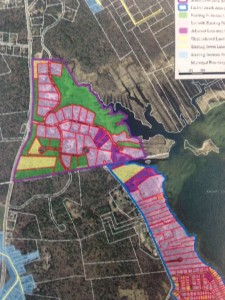The Town of Marion is hoping to secure a $200,000 grant from the Buzzards Bay National Estuary Program, and on September 15 during a special afternoon meeting, they signed the pre-proposal submittal with Buzzards Bay Coalition representative Rachel Jakuba present to assist in the application process.
The BBC contacted the Town of Marion and alerted them to the grant opportunity in light of the difficulties the town faces securing its National Pollutant Discharge Elimination Systems (NPDES) permit from the Massachusetts Department of Environmental Protection. The town faces possibly tens of millions of dollars in costs should it be forced to eliminate the usage of its three wastewater treatment lagoons and upgrade the wastewater treatment facility.
“We need to act expeditiously,” said Town Administrator Paul Dawson to selectmen. The pre-proposal was due that afternoon by 4:00 pm and, as far as Dawson was concerned, this grant was an opportunity to essentially receive funding for an endeavor the town would otherwise already have to undertake.
The town’s proposed project for the grant, titled “Aucoot Cove Partnership to Reduce Nitrogen from Septic Systems,” would expand municipal sewer services to approximately 151 homes in the Indian Cove neighborhood in Marion and the Harbor Beach neighborhood of Mattapoisett, which could potentially reduce nitrogen levels in Aucoot Cove and its sub-embayment, Hiller Cove, by 4,700 pounds of nitrogen per year.
This grant would fund the initial feasibility study of the sewer service expansion.
The town is partnering with the Town of Mattapoisett and the BBC, which will contribute $10,000 towards the feasibility study, and those residences in Harbor Beach could eventually be able to tie in to Marion’s expanded municipal sewer services.
Nitrogen pollution from cesspools and septic systems in these two neighborhoods discharges roughly 5,307 pounds of nitrogen per year, and is one of the significant reasons why Aucoot Cove is listed as a Category 5 water on the Final Massachusetts Year 2012 Integrated List of Waters (the “303d” list) as Nutrient Impaired. Expanding the sewer system would reduce the neighborhoods’ output of nitrogen by 90 percent.
As part of acceptance of the grant, the Town of Marion would have to contribute $50,000 to the project, with the project funding totaling $260,000 from the three sources. An article requesting the $50,000 funding will appear on the Fall Special Town Meeting warrant.
Dawson said the Town’s attempt to secure the grant to reduce nitrogen levels in Aucoot Cove might reflect positively on the DEP as it considers the fate of Marion’s NPDES permit.
“It could be helpful to us and our discussions with us and the DEP and the NPDES permit,” said Dawson. “It would look favorably on the town … but there’s no guarantees of that.”
Nonetheless, the town would indeed benefit in at least one way, said Dawson.
“This is an important step in regional cooperation,” said Dawson. “…Everything that could possibly be done to take nitrogen sources out … should be done.”
“We would be the lead town in this action … and [Mattapoisett] would tie in to us and pay the fees,” said Selectman Jonathan Henry. “I consider the offer to broker this deal … a very important step in that direction…. This is a very good example of inter-municipal cooperation.”
The next meeting of the Marion Board of Selectmen is scheduled for September
22 at 7:00 pm at the Marion Town House.
By Jean Perry
